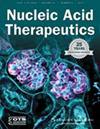Delivery Characterization of SPL84 Inhaled Antisense Oligonucleotide
IF 4.7
2区 医学
Q2 BIOCHEMISTRY & MOLECULAR BIOLOGY
引用次数: 4
Abstract
The last years have shown enormous advancement in the therapeutic potential of RNA-related treatments, specifically for antisense oligonucleotide (ASO)-based drugs, leading to increased numbers of ASO regulatory approvals. In this study we focus on SPL84, an inhaled ASO-based drug, developed for the treatment of the pulmonary disease, Cystic Fibrosis (CF). Pulmonary drug delivery is challenging, due to a variety of biological, physical, chemical, and structural barriers, especially when aiming to target the cell nucleus. The efficient distribution of SPL84 in the lungs, penetration into the cells and nucleus, and stability are critical parameters that will impact drug efficacy in a clinical setting. In this study, we demonstrate the proper distribution and cell and nucleus penetration of SPL84 in mouse and monkey lungs. In vivo and in vitro studies confirmed the stability and mobility of our inhaled ASO drug through CF patient-derived mucus and in lung lysosomal extracts. Our results, supported by a promising pre-clinical pharmacological effect, emphasize the high potential of SPL84 as an effective drug for the treatment of CF patients. In addition, successfully tackling the lung distribution of SPL84 and specific cell targeting offers huge opportunities for further development of SpliSense inhaled ASO-based drugs for unmet pulmonary diseases.SPL84吸入反义寡核苷酸的递送特性
近年来,RNA相关治疗的治疗潜力取得了巨大进展,特别是基于反义寡核苷酸(ASO)的药物,导致ASO监管批准的数量增加。在这项研究中,我们重点关注SPL84,这是一种基于ASO的吸入性药物,用于治疗肺部疾病囊性纤维化(CF)。由于存在各种生物、物理、化学和结构障碍,尤其是在靶向细胞核时,肺部给药具有挑战性。SPL84在肺部的有效分布、对细胞和细胞核的渗透以及稳定性是影响临床疗效的关键参数。在这项研究中,我们证明了SPL84在小鼠和猴子肺中的正确分布以及细胞和细胞核的穿透。体内和体外研究证实了我们吸入的ASO药物通过CF患者来源的粘液和肺溶酶体提取物的稳定性和流动性。我们的研究结果得到了有前景的临床前药理作用的支持,强调了SPL84作为治疗CF患者的有效药物的高潜力。此外,成功解决SPL84的肺部分布和特异性细胞靶向为进一步开发基于SpliSense吸入ASO的药物治疗未满足的肺部疾病提供了巨大机会。
本文章由计算机程序翻译,如有差异,请以英文原文为准。
求助全文
约1分钟内获得全文
求助全文
来源期刊

Nucleic acid therapeutics
BIOCHEMISTRY & MOLECULAR BIOLOGY-CHEMISTRY, MEDICINAL
CiteScore
7.60
自引率
7.50%
发文量
47
审稿时长
>12 weeks
期刊介绍:
Nucleic Acid Therapeutics is the leading journal in its field focusing on cutting-edge basic research, therapeutic applications, and drug development using nucleic acids or related compounds to alter gene expression. The Journal examines many new approaches for using nucleic acids as therapeutic agents or in modifying nucleic acids for therapeutic purposes including: oligonucleotides, gene modification, aptamers, RNA nanoparticles, and ribozymes.
 求助内容:
求助内容: 应助结果提醒方式:
应助结果提醒方式:


